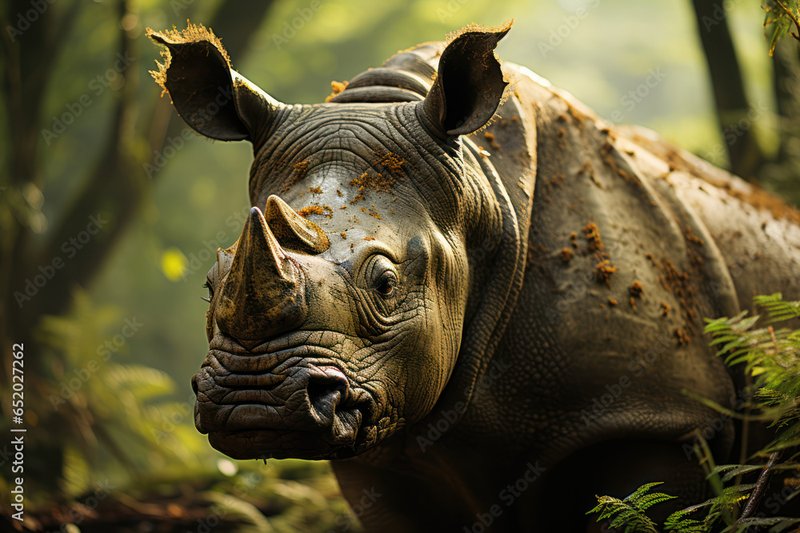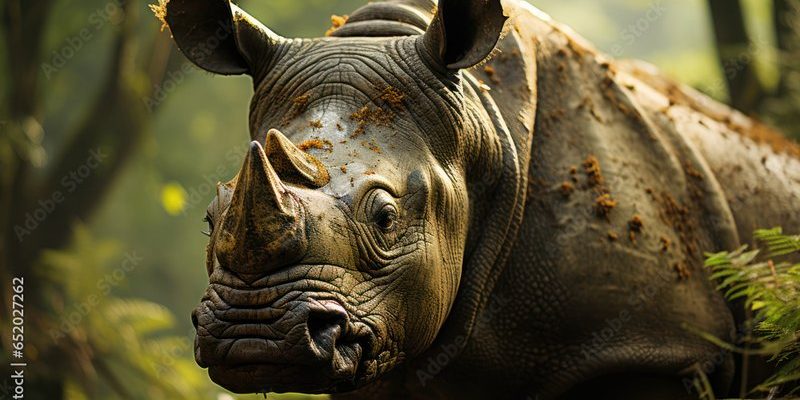
The Javan Rhinoceros is one of the rarest large mammals on Earth, and it’s quite a unique creature. Picture a hefty, armored animal with a single horn—something that looks like it walked straight out of a prehistoric era. Found only in a small region of Indonesia, this magnificent rhino symbolizes nature’s beauty and fragility. Unfortunately, it also embodies the struggles many species face today due to habitat loss and poaching.
Imagine wandering through a lush tropical rainforest, where the air is thick with humidity and the sounds of exotic birds fill the space. Suddenly, you come across this massive, solitary creature grazing quietly. It is a sight that stirs awe and a sense of urgency to protect these precious animals. Despite their incredible adaptations, Javan Rhinos are on the brink of extinction, and understanding them is key to ensuring their survival.
Physical Characteristics
The Javan Rhinoceros is distinct from other rhinoceros species, primarily due to its well-defined features. Adults can weigh between 1,800 to 2,200 pounds and typically measure around 10 to 13 feet in length. They have a single horn, which can grow up to 10 inches long, and a thick, loose skin that appears to be armored, giving them a prehistoric look.
Unlike their more massive relatives, the Javan Rhino is comparatively smaller and has a more slender build. Their skin has a series of folds and wrinkles that resemble armor plating, which is not just for show; it helps protect them from the thorns and rugged terrain of their forest habitat. Their coloration is typically a dark gray or brown, blending seamlessly with the forest floor and undergrowth.
Habitat and Distribution
The Javan Rhinoceros primarily inhabits the Ujung Kulon National Park in Indonesia, which is a UNESCO World Heritage Site. This park offers a mix of dense rainforest, grasslands, and mangrove swamps, making it an ideal home for these rhinos. The park’s dense vegetation provides not only shelter but also a rich source of food, including leaves, shoots, and fruits.
Sadly, the Javan Rhino’s habitat is extremely limited. The park is the last refuge for the species, and any natural disasters or changes in climate can severely impact their survival. Additionally, encroachment from agriculture and urban development poses a significant threat to their habitat, making conservation efforts crucial. While this area is protected, the need for ongoing management and monitoring is vital to ensure the population can thrive.
Diet and Feeding Habits
Diet-wise, Javan Rhinos are herbivores, which means they feast on a variety of plant materials. Their diet primarily consists of leaves, fruits, and shoots found in their forest environment. Using their remarkable sense of smell, they can forage efficiently even in dense thickets. You might be surprised to learn that they enjoy a good snack of fallen fruits and tender young plants, which are abundant in the tropical landscape.
Interestingly, Javan Rhinos have been observed to wallow in mud. This behavior not only helps them cool off but also plays a role in skin protection. The mud provides a layer of sunscreen against the sun’s harsh rays and helps keep their skin hydrated and free from parasites. It’s a fascinating example of how their diet and behavior are perfectly adapted to their environment.
Behavior and Social Structure
The social structure of Javan Rhinoceros is primarily solitary. Unlike some other rhinoceros species that form groups, Javan Rhinos prefer to live alone, with the exception of mothers and their calves. This solitary lifestyle helps them avoid competition for food and reduces the risk of confrontation with other rhinos. Occasional interactions happen during mating or when a mother is raising her young.
These rhinos are mostly nocturnal, meaning they are most active at night when the temperature is cooler, and the forest is buzzing with life. During the day, you’ll often find them resting in dense vegetation, conserving energy. Their ability to thrive in low-light conditions is a fascinating adaptation, as it allows them to safely navigate their habitat while avoiding potential threats.
Conservation Status
The Javan Rhinoceros is critically endangered, with estimates suggesting that only about 70 individuals remain in the wild. This alarmingly low number is primarily due to habitat loss from deforestation and poaching, driven by the illegal wildlife trade. As their habitats shrink and the threats to their existence grow, conservation efforts have become more critical than ever.
Organizations around the world are working tirelessly to protect the Javan Rhino. In Ujung Kulon National Park, ongoing monitoring and specific protection strategies are in place to safeguard the remaining rhinos. Anti-poaching measures and habitat restoration projects are crucial components of these efforts, ensuring that this incredible species has a chance for survival. It’s a delicate balance, and every action counts.
Interesting Facts
| Scientific Name: | Rhinoceros sondaicus |
| Size: | 10 to 13 feet in length |
| Weight: | 1,800 to 2,200 pounds |
| Habitat: | Ujung Kulon National Park, Indonesia |
| Diet: | Herbivore – leaves, fruits, and shoots |
| Lifespan: | Up to 30-40 years in the wild |
| Population: | Approximately 70 individuals |
Threats to the Javan Rhinoceros
The threats facing the Javan Rhinoceros are multifaceted and deeply concerning. Poaching poses a significant threat, as their horn is highly valued in traditional medicine and as a status symbol in some cultures. Despite being illegal, the demand drives poachers to target these incredible animals. The Javan Rhino’s single horn makes them particularly vulnerable since it’s easy for poachers to spot and target them.
In addition to poaching, habitat destruction remains a major concern. As agriculture expands and human populations grow, the natural landscapes that Javan Rhinos call home are increasingly fragmented. This loss of habitat not only reduces their living space but also diminishes the food sources essential for their survival. Without immediate conservation efforts, these challenges could lead to the species’ extinction.
Conservation Efforts
There are significant conservation efforts underway to protect the Javan Rhinoceros. Conservation organizations are closely monitoring the remaining population and working on habitat restoration projects to ensure their survival. Anti-poaching units patrol Ujung Kulon National Park to deter illegal hunting and safeguard rhinos in their natural habitat. These dedicated teams are crucial in the fight against poaching.
Another essential part of these efforts is raising awareness and engaging local communities. Educating people about the importance of the Javan Rhino and its role in the ecosystem can foster a sense of responsibility and encourage community members to protect their natural resources. Engaging local populations in conservation initiatives is a vital step to ensuring that rhinos can coexist with human activities.
How You Can Help
You might be wondering how you can make a difference. Supporting wildlife conservation organizations that focus on protecting the Javan Rhinoceros is a powerful way to contribute. Donations can help fund anti-poaching efforts, habitat restoration, and community education programs. Additionally, raising awareness about the plight of the Javan Rhino within your own circles can help spread the word and inspire others to take action.
If you plan to visit areas where rhinos live, consider eco-tourism options that emphasize sustainable practices. These experiences not only provide economic benefits to local communities but also offer a chance to observe wildlife responsibly. Every small action can contribute to the larger goal of protecting these incredible creatures.
FAQ
What is the Javan Rhinoceros’ primary diet?
The Javan Rhinoceros primarily feeds on leaves, fruits, and tender shoots found in its rainforest habitat. Its herbivorous diet allows it to thrive in the lush environment of Ujung Kulon National Park, where food sources are plentiful.
How does the Javan Rhinoceros protect itself from the sun?
Javan Rhinos often wallow in mud, which helps shield their skin from the sun’s rays. This mud acts like a natural sunscreen, protecting them from sunburn and keeping their skin hydrated.
Why is the Javan Rhinoceros critically endangered?
The Javan Rhinoceros is critically endangered primarily due to habitat loss caused by agriculture and urban development, as well as poaching driven by the illegal wildlife trade. Conservation efforts are crucial to their survival.
Where can I find Javan Rhinoceros in the wild?
The Javan Rhinoceros can only be found in Ujung Kulon National Park in Indonesia. This protected area is crucial for their survival, as it is the last remaining habitat for the species.
How long do Javan Rhinoceros live?
In the wild, Javan Rhinos can live for about 30 to 40 years. Their longevity is influenced by factors like habitat quality, food availability, and the absence of human threats.
What are the main threats to the Javan Rhinoceros?
The main threats to the Javan Rhinoceros include poaching for their valuable horn and habitat loss due to agricultural expansion and urban development. These combined factors pose significant challenges to their survival.
How can I help in the conservation of Javan Rhinoceros?
You can help in the conservation of the Javan Rhinoceros by supporting wildlife conservation organizations, spreading awareness about their plight, and considering eco-tourism options that benefit local communities while protecting wildlife.
Are there any successful conservation efforts for the Javan Rhinoceros?
Yes, there are ongoing conservation efforts, such as anti-poaching patrols and habitat restoration projects in Ujung Kulon National Park. These efforts are crucial for protecting the remaining population of Javan Rhinos.
Do Javan Rhinoceros have any predators?
Adult Javan Rhinoceros have very few natural predators due to their size and strength. However, young calves can be vulnerable to large predators like tigers in the wild.
What distinguishes the Javan Rhinoceros from other rhino species?
The Javan Rhinoceros is distinguished by its smaller size, the presence of a single horn, and its unique adaptations to a dense forest habitat, making it quite different from other rhino species that may have two horns and larger physiques.
Can Javan Rhinoceros be bred in captivity?
There have been attempts to breed Javan Rhinoceros in captivity, but it has proven challenging due to their solitary nature and specific habitat needs. Conservationists continue to explore options to support their reproduction while protecting their wild populations.
What role does the Javan Rhinoceros play in its ecosystem?
The Javan Rhinoceros plays a vital role in its ecosystem by helping to maintain the health of the forest. As herbivores, they contribute to plant growth and seed dispersal, which supports biodiversity in their habitat.
How does climate change impact Javan Rhinoceros habitats?
Climate change can affect the Javan Rhinoceros by altering weather patterns that influence their habitat. Changes in rainfall and temperature can impact food availability and overall habitat suitability, posing a significant threat to their survival.

